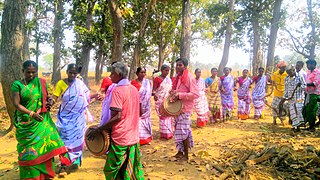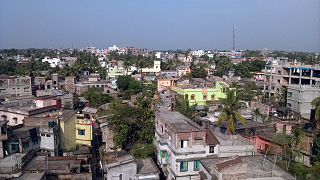
The Santal or Santhal are an Austroasiatic speaking Munda ethnic group in South Asia. Santals are the largest tribe in the Jharkhand and West Bengal state of India in terms of population and are also found in the states of Odisha, Bihar and Assam. They are the largest ethnic minority in northern Bangladesh's Rajshahi Division and Rangpur Division. They have a sizeable population in Nepal. The Santals speak Santali, the most widely spoken Munda languages of Austro-asiatic language family.

Sidhu Murmu and Kanhu Murmu were the leaders of the Santhal rebellion (1855–1856), the rebellion in present-day Jharkhand and Bengal in eastern India against both the British colonial authority and the corrupt zamindari system.

Droṇa, also referred to as Dronacharya, is a major character of the Hindu epic Mahabharata.

Birbhum district is an administrative unit in the Indian state of West Bengal. It is the northernmost district of Burdwan division—one of the five administrative divisions of West Bengal. The district headquarters is in Suri. Other important cities are Bolpur, Rampurhat and Sainthia. Jamtara, Dumka and Pakur districts of the state of Jharkhand lie at the western border of this district; the border in other directions is covered by the districts of Bardhaman and Murshidabad of West Bengal.

Deoghar district is one of the twenty-four districts of Jharkhand state in eastern India. Deoghar, the central city of the district, is also its administrative headquarters. This district is known for the Baidyanath Jyotirlinga shrine and is a part of the Santhal Pargana division. Deoghar is a Hindi word meaning abode (‘ghar’) of the Gods and Goddesses (‘dev’). Deoghar is also known as “Baidyanath Dham,” and “Baba Dham,”.
The tribes of Jharkhand consist of 32 scheduled tribes inhabiting the Jharkhand state in India. In 1872, only 18 tribes were counted among the schedule tribes from which Banjara, Bhatudi, Chik Baraik and Mahli were marked as semi-Hindu aboriginal and Kora as proletariat Hindu. In the 1931 census, including above four semi-Hindu aboriginal and Kora, a proletariat Hindu, the number was raised to 26 from 18 by adding four more in the annexure. They were Birajia, Godait, Karmali and Paharia, but Kisan was excluded from the list. In 1941 census, Baga, Bedia and Lohra included again taking Kisan in the annexure and number came to 30 which was prevailing till June 2003. Kanwar and Kol were added on 8 June 2003 in the annexure and the number of Schedule Tribes came to 32.

Jayadratha is the king of the Sindhu kingdom featured in the Mahabharata. He was married to Dushala, the only sister of the hundred Kaurava brothers. The son of the king Vriddhakshatra, he is killed by Arjuna. He has a son named Suratha.

Rampurhat is a city and a municipality in Birbhum district in the Indian state of West Bengal. It is the headquarters of the Rampurhat subdivision. According to Census 2011 Rampurhat is the third most populous city in Birbhum district and 82nd most populous city in West Bengal. Rampurhat is a rapidly growing township It is near the West Bengal / Jharkhand border. Rampuhat is an important city of Birbhum district as it has dynamic connectivity with the other places of West Bengal and neighboring states via state highways, national highway and rail route. Rampurhat Junction is one of the busiest railway stations in eastern India.
The Tea-garden community are multi ethnic groups of tea garden workers and their descendants in Assam. They are officially referred to as Tea-tribes by Government of Assam. They are the descendants of peoples brought by the British colonial planters as indentured labourers from the regions of present-day Jharkhand, Odisha, Chhattisgarh, West Bengal and Andhra Pradesh into colonial Assam during 1860-90s in multiple phases to work in tea gardens. They are heterogeneous, multi-ethnic groups which includes many tribal and caste groups. They are found mainly in those districts of Upper Assam and Northern Brahmaputra belt where there is high concentration of tea gardens like Kokrajhar, Udalguri, Sonitpur, Biswanath,Nagaon, Golaghat, Jorhat, Sivasagar, Charaideo, Dibrugarh, Tinsukia, Lakhimpur. There is a sizeable population of the community in the Barak Valley region of Assam as well in the districts of Cachar, Karimganj and Hailakandi. The total population is estimated to be around 7 million of which estimated 4.5 million reside in residential quarters built inside 799 tea estates spread across tea growing regions of Assam. Another 2.5 million reside in the nearby villages spread across those tea growing regions. They are not a single ethnic group but consists of different ethnic group speaking dozens of languages and have different set of cultures. They speak several languages including Sora, Odia, Assam Sadri, Sambalpuri, Kurmali, Santali, Kurukh, Kharia, Kui, Chhattisgarhi, Gondi and Mundari. Assam Sadri, distinguished from Sadri language, serve as lingua franca among the community.
Labhpur is a census town in Labpur CD block in Bolpur subdivision of Birbhum district in the Indian state of West Bengal. It is known to the outside world as the native place of Tarashankar Bandopadhyay and one of the 51 Shakti Peethas.
Culture of Birbhum refers to the culture of Birbhum district in the Indian state of West Bengal.
Purandarpur is a village in Suri II CD block in Suri Sadar subdivision of Birbhum district in the state of West Bengal, India.

Gonpur is an old village in Mohammad Bazar CD Block in Suri Sadar subdivision of Birbhum district, West Bengal, India.
Bhognadih is a village in the Barhait CD block in the Sahibganj subdivision of the Sahibganj district of the Jharkhand State, India. Bhognadih has a place in history, as the main centre of the Santhal rebellion.
Kurumgram is an old village located in Nalhati I CD Block in Rampurhat subdivision of Birbhum district in West Bengal State of India.
Margarm is a village and gram panchayat in Rampurhat II CD Block in Rampurhat subdivision of Birbhum district in the Indian state of West Bengal.
Kotasur is a census town in Mayureswar II CD Block in Rampurhat subdivision of Birbhum district in the Indian state of West Bengal. It is situated in the bank of river Mayurakshi..

Deoghar subdivision is an administrative subdivision of the Deoghar district in the Santhal Pargana division in the state of Jharkhand, India.
Sahibganj subdivision is an administrative subdivision of the Sahibganj district in the Santhal Pargana division in the state of Jharkhand, India.
Rajmahal subdivision is an administrative subdivision of the Sahibganj district in the Santhal Pargana division in the state of Jharkhand, India.










